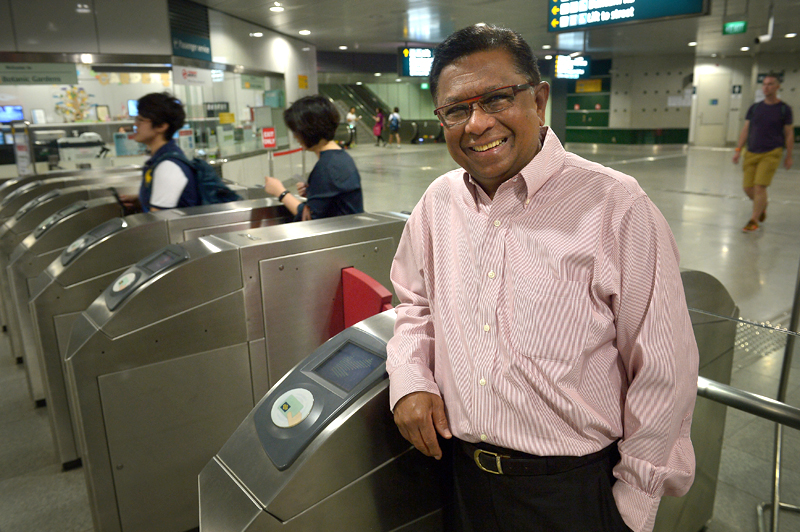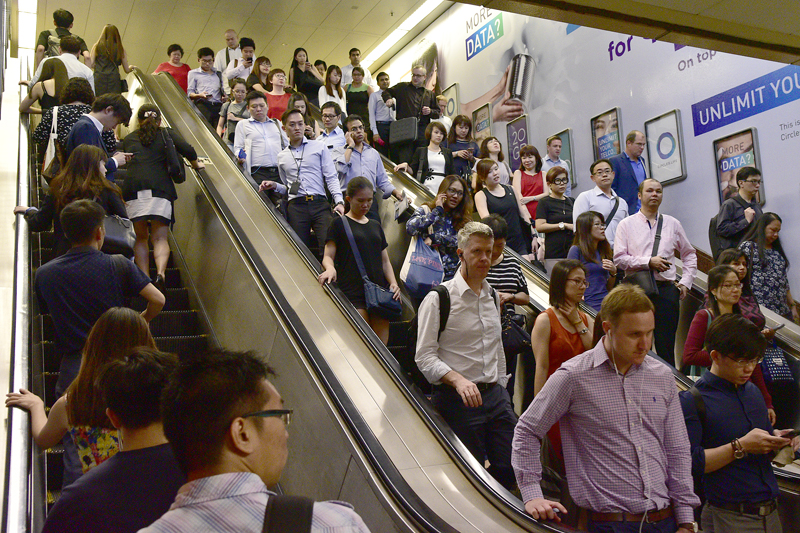At the entrance to the Basic Military Training Centre (BMTC) on Pulau Tekong stands a large map detailing the British defences in Singapore that date back to February 1942 - the month the island was invaded by Japanese forces.
The message to new recruits training to bear arms for Singapore is clear: the suffering endured during World War II reminds Singaporeans that they can rely only on themselves to defend their homeland.
The need for a strong defence was reiterated by Defence Minister Ng Eng Hen this year as Singapore marked two important milestones - the 75th anniversary of the fall of Singapore and 50 years of national service (NS).
During the anniversary of the British surrender on Feb 15, Dr Ng recounted how the "bitter but valuable lessons" of brutal Japanese rule spurred the pioneer generation of Singaporeans to implement NS to keep the nation independent and safe.
And the country cannot let its guard down, even in times of peace, said Dr Ng, as he launched a year-long series of events to commemorate 50 years of NS - which began formally with the passage of the National Service (Amendment) Act on Mar 14, 1967.
To drive home the point, Dr Ng raised the cautionary tale of Lithuania, which abolished NS to reap the peace dividend derived at the end of the Cold War, only to announce that it was reinstating conscription two years ago due to rising instability in its region.
PERCEPTION OF THREAT
Indeed, external threats faced by a country can be a powerful impetus for NS.
It seems intuitive that the higher the security threat a country faces, the more its citizens will want to defend their homeland.
However, that alone cannot fully predict a country's will to sustain the institution.
In Switzerland, which has long cherished its neutrality in international affairs, voters overwhelmingly rejected three attempts to eliminate NS in a 25-year span.
The last referendum on the issue in 2013 saw 73 per cent of voters choosing to maintain its conscription army.
Closer to home, Taiwan too has tried to do away with NS and transition to a fully regular force.
China claims the island as a renegade province to be reclaimed - by force if necessary - and Taiwan has faced rising cross-strait tensions since the pro-independence Democratic Progressive Party took power this year.
Clearly, there are other forces at play besides the threat level in determining the approach to NS that is ultimately chosen.
Defence analyst Ho Shu Huang from the S. Rajaratnam School of International Studies (RSIS) pointed out that, like Singapore, Switzerland has been consistent in explaining the need for conscription.
"It's become part of the Swiss way of life, a marker of identity," he said.
Proponents of compulsory military service in Switzerland also believe that it plays a crucial role in nation-building, uniting a country with three main language groups.
This holds parallels to how NS cemented Singaporeans' commitment to their nascent nation and has come to be seen as a social leveller and a rite of passage.
Young people from diverse backgrounds are made to train and live together.
Many are toughened by their first extended period away from home and also bond due to their common experience in the barracks.
On NS in Taiwan, Mr Ho said issues over the years, such as the poor quality of equipment issued to soldiers, have affected public sentiment.
Confidence in the military has also been eroded by embarrassing bungles such as the navy's misfiring of an anti-ship missile that killed a fisherman last year.
As a result, young Taiwanese men increasingly do not see NS as a patriotic duty.
Instead, a significant number believe it is a waste of time as the military is not considered a credible deterrent against China.
In Singapore, support for NS is sky-high, with a 2013 Institute of Policy Studies survey reporting that 98 per cent of Singaporeans believe the institution is crucial for national security.
But to maintain the current high level of support, Singapore should examine what factors - besides a drop in threat perception - can undermine this vital institution.
SENSE OF FAIRNESS
As an operationally ready national serviceman (NSman) in the army, foremost in my mind is the sense of fairness in the system.
I do not mind doing my time in the military so long as my fellow male citizens do their part.
It is obvious that the Defence Ministry (Mindef) is well aware of the importance of keeping NS equitable.
The authorities come down hard on draft dodgers to show that people cannot get away with gaming the system.
When swimmer Joseph Schooling won Singapore's first Olympic gold medal, there was a public call for him to be granted a further deferment to his NS obligations.
Singapore citizen and second-generation permanent resident males enlist for NS at age 18.
The time served is typically two years.
Some are allowed to defer their NS, but deferment is granted sparingly.
Singaporeans know that, given how strict NS policy is, a deferment is by no means guaranteed - even under extraordinary circumstances.
However, it cannot be assumed that such a stringent draft is the natural state of affairs.
South Korea, which is still technically at war with its northern neighbour, has several exemptions to NS, such as allowing those with master's degrees in engineering to choose to work for three years at a research institute.
But after realising its military was facing a manpower crunch, it announced last year that it would scrap most NS exemptions.
Meanwhile, compulsory military service in Israel is supposedly more universal than in most other places, as both men and women are conscripted.
But in practice, barely half of all Israeli citizens are drafted and even less are called up for reserve duty, according to a 2010 book titled The New Citizen Armies.
These countries have larger populations to draw from and can therefore adopt a laxer approach.
South Korea's population of 51 million is almost 10 times that of Singapore's.
So while both countries' militaries are made up mostly of conscripts who serve about two years of NS, South Korea has a force of 630,000 active troops while Singapore has about 72,500 active personnel.
Israel also gets a boost from the significant number of people from overseas with Jewish roots who sign up voluntarily to serve with the Israeli Defence Force.
Singapore, with its small population, has no luxury of being lenient with its NS policy.
Every soldier, sailor, and airman is precious.
However, while everyone goes through the same two years of NS, some serve in more physically demanding and challenging roles than others.
Perhaps the authorities should be cautious about the possibility of resentment building up due to a perceived inequality in sacrifice and contribution by those who take on tougher vocations.
In the case of Israel, it has been reported that those who are frequently summoned for reserve duty are usually the best trained and most battle-tested troops.
These soldiers thus harbour "an understandable feeling that they now constitute a dwindling band of suckers" as some fellow citizens do not pull their weight in defending the country, according to the 2008 book Israel And Its Army.
Mr Ho does not sense that the same negative sentiments are present here, as most NSmen serve reservist stints and there is the impression that everyone puts in the same time commitment.
Said the defence analyst: "Again, this is an example of parity in the distribution of the burden which is so important."
And even though some vocations are seen as more prestigious than others, Mr Ho added: "I don't think anyone's made to feel bad about how they served national service."
Certainly, when I was serving full-time NS more than 10 years ago, there was casual talk about how those in support or logistics roles had it better than those in combat roles.
But in my experience, no one dwelled on those feelings.
There was a far greater sense of injustice over matters such as getting more cleaning duties or guard duties than the neighbouring platoon.
And whatever sense of superiority we had diminished during reservist trainings as we came back as more mature adults, understanding that all roles play a part in keeping the military ticking.
MEANING OF SERVICE
Even so, Mindef has moved to reduce the luck of the draw when it comes to vocations by allowing those who enlist from November this year to indicate their preferences in vocations.
This will no doubt help give full-time national servicemen (NSFs) and NSmen a more meaningful experience in the military and maximise their contributions.
It will also decrease cynicism that some feel towards serving NS because they are not gainfully employed during their two years in uniform.
I see NS as a sacrifice to be shouldered. I believe that men like me will continue to serve NS even if there are unpleasant elements to it.
Perhaps one day it will be seen as a privilege to serve NS. We are not there yet, but I believe we are headed in the right direction.
NS is a fundamental element to Singapore's ability to defend itself.
And so it is imperative that Mindef continues to keep an eye out for issues that might shake the nation's commitment to this institution.
What if Singapore endures a prolonged economic slump and can no longer support Mindef's budget - the highest among all ministries - or if Singaporeans start believing that the country can make do with a military of career soldiers?
But some may ask why there is a need to think of ways to improve NS, especially when support for it seems rock solid.
On this note, it is worth paying heed to a second lesson to be drawn from the map displayed at BMTC, which shows that all British defences were concentrated in Singapore's south.
There was a blind spot then, as military commanders failed to pay attention to the island's north - which is where the Japanese invaders eventually attacked from.
Singaporeans should similarly think deeply about potential blind spots and hidden issues that can undermine public support for NS.
The 50th year of NS provides an opportune time to start a new conversation on ways to guard against the potential pitfalls facing this national institution.
ziliang@sph.com.sg
![]()
This article was first published on April 6, 2017.
Get a copy of The Straits Times or go to straitstimes.com for more stories.























































































































































































































































































